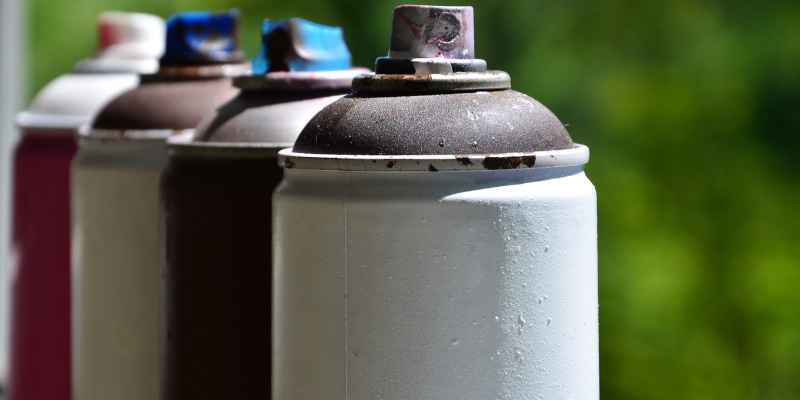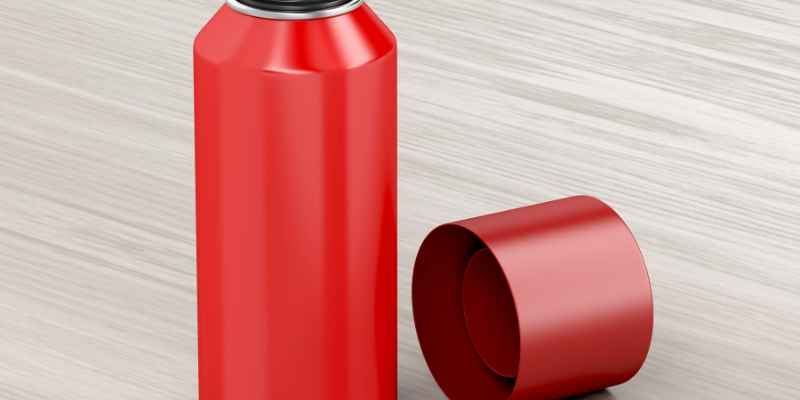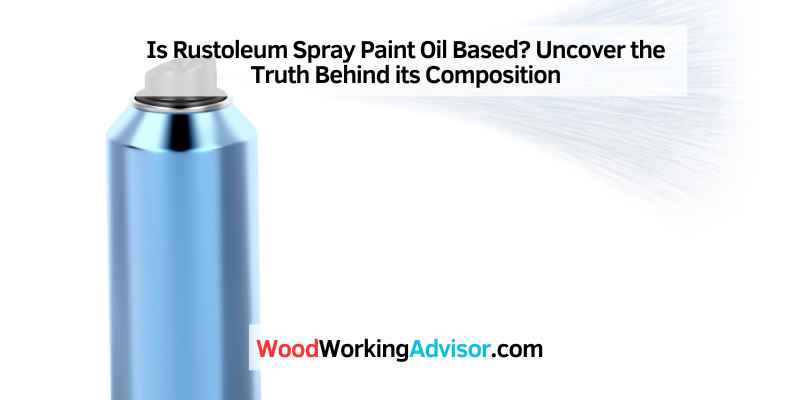Yes, Rustoleum Spray Paint is oil-based. It is a popular choice for its durability and smooth finish.
Rustoleum Spray Paint is known for its high-quality, oil-based formula. With its exceptional durability and smooth finish, it is a top choice among DIY enthusiasts and professionals alike. Whether you’re looking to refresh the color of furniture, metal fixtures, or outdoor surfaces, Rustoleum Spray Paint provides excellent coverage and long-lasting results.
Its oil-based composition ensures a strong bond to surfaces, making it resistant to chipping, cracking, and fading. Available in a wide range of colors and finishes, Rustoleum Spray Paint is an easy-to-use solution for achieving a professional-looking paint job. So, if you’re seeking a reliable and durable spray paint option, Rustoleum’s oil-based formula is definitely worth considering.
Understanding Rustoleum Spray Paint
Rustoleum spray paint is known for its quality and versatility. The composition of Rustoleum spray paint is a key factor in its effectiveness. It is an oil-based paint, which means that its main ingredient is oil rather than water.
Unlike water-based paints, oil-based paints dry through a process of oxidation rather than evaporation. This means that they form a hard, tough surface that is resistant to wear and tear. The oil in Rustoleum spray paint provides excellent adhesion to a variety of surfaces, including wood, metal, and plastic.
One of the advantages of using an oil-based paint like Rustoleum is its ability to provide long-lasting protection. The oil base creates a barrier that helps prevent rust, corrosion, and weathering. It also offers superior coverage and durability, making it suitable for both indoor and outdoor projects.
Different Types Of Rustoleum Spray Paint
Rustoleum offers a wide range of spray paints to suit different applications and surfaces. Here are some of the popular types:
| Type | Features |
|---|---|
| Universal | Designed for various surfaces, including wood, metal, plastic, and more. Offers excellent coverage and durability. |
| Enamel | Provides a smooth, glossy finish. Ideal for projects that require a high level of durability and protection. |
| Painter’s Touch | Offers a wide range of colors and finishes. Quick-drying and suitable for both indoor and outdoor use. |
| Ultra Cover 2X | Delivers twice the coverage of other spray paints. Ideal for large projects and provides a durable finish. |
These are just a few examples of the different types of Rustoleum spray paint available. Each type is formulated with specific features and benefits to meet the needs of different projects.

Oil-based Or Not? The Myth Debunked
One of the most common questions asked by DIY enthusiasts and professionals alike is whether Rustoleum spray paint is oil-based or not. This myth has been circulating for years, leading to confusion among users who want to make the best choice for their projects. In this article, we will explore the myth and provide you with a clear answer to help you make an informed decision.
Exploring The Myth
There has been a misconception that all Rustoleum spray paints are oil-based. However, this is not entirely accurate. While Rustoleum does offer oil-based spray paint options, they also have a wide range of products that are water-based or acrylic-based.
Oil-based spray paints are known for their durability and moisture resistance, making them an excellent choice for outdoor projects or surfaces prone to exposure to harsh weather conditions. They provide a long-lasting finish that can withstand wear and tear.
On the other hand, water-based and acrylic-based spray paints have their own advantages. They dry quickly, have low VOC emissions, and are generally easier to clean up. They are suitable for a variety of indoor projects and offer a wide range of color options to choose from.
Rustoleum Spray Paint Formulation
Rustoleum spray paints are known for their high-quality formulations, which provide professional-looking results. Their oil-based options typically contain a blend of solvents, pigments, and resins that create a durable and glossy finish.
The water-based and acrylic-based variants, on the other hand, usually contain water as the primary solvent along with acrylic resins and pigments. These formulations dry quickly and provide a smooth and even coverage.
To determine whether a particular Rustoleum spray paint is oil-based or not, you can refer to the product label or check the specifications provided by the manufacturer. They will clearly indicate the type of formulation used for that specific product.
It’s important to note that each formulation has its own characteristics and is suitable for different applications. Therefore, it’s crucial to consider the specific requirements of your project before choosing the right Rustoleum spray paint.
Understanding whether Rustoleum spray paint is oil-based or not can help you select the right product for your needs. Whether you’re working on a metal surface, wood, or plastic, knowing the formulation will ensure that you achieve the desired results – a professional-looking finish that lasts.
Advantages And Disadvantages Of Oil-based Spray Paint
The use of spray paint has become increasingly popular for various DIY projects, and there are several different types available on the market. One of the options to consider is Rustoleum spray paint, which is known for its durability and versatility. However, when it comes to choosing the right spray paint for your project, it’s important to understand the advantages and disadvantages of oil-based spray paint.
Pros Of Oil-based Spray Paint
Oil-based spray paint offers several advantages that make it a popular choice among DIY enthusiasts. Here are some of the benefits to consider:
- Excellent Coverage: Oil-based spray paint provides excellent coverage, ensuring that you can achieve a smooth and even finish on various surfaces.
- Durability: This type of spray paint is known for its durability, making it an excellent option for outdoor projects that require long-lasting protection against the elements.
- Smooth Finish: Oil-based spray paint offers a smooth and glossy finish, giving your project a professional and polished look.
- Versatility: It can be used on a wide range of surfaces, including wood, metal, plastic, and more, making it a versatile option for different projects.
- Resistance: Oil-based spray paint is resistant to chipping, fading, and peeling, ensuring that your project maintains its vibrant appearance for an extended period.
Cons Of Oil-based Spray Paint
While oil-based spray paint has its advantages, there are also some drawbacks to consider. Here are a few cons:
- Strong Odor: Oil-based spray paint emits a strong and sometimes unpleasant odor, so it’s essential to use it in a well-ventilated area.
- Drying Time: It generally takes longer for oil-based spray paint to dry compared to other types, which can be an inconvenience if you need to finish your project quickly.
- Cleanup: Cleaning up oil-based spray paint requires the use of solvents or mineral spirits, which adds an extra step to the painting process.
- Expensive: Oil-based spray paint tends to be more expensive than other types, making it a less budget-friendly option for some projects.
- Environmental Impact: Oil-based spray paint contains volatile organic compounds (VOCs), which can have a negative impact on the environment and personal health if not used responsibly.
Alternative Formulations
Rustoleum Spray Paint offers alternative formulations, including oil-based options, for versatile and durable coverage. Discover its range of products for your painting needs.
Water-based Spray Paint Options
When it comes to alternative formulations, water-based spray paint options provide a convenient and eco-friendly solution. These paints, which use water as the primary solvent instead of oil, offer a range of benefits that make them popular among DIY enthusiasts and professional painters alike.
One of the key advantages of water-based spray paint is its low odor. Unlike oil-based paints, which can emit strong fumes during application and drying, water-based paints have a much milder odor, making them more pleasant to work with and reducing the risk of respiratory irritation.
In addition to being less odorous, water-based spray paints dry faster than their oil-based counterparts. This means less waiting time between coats or finishing touches, enabling you to complete your project more efficiently. Plus, the quick drying time helps minimize the chances of dust or other particles settling on the painted surface, resulting in a smoother, more professional-looking finish.
Furthermore, water-based spray paints are easier to clean up. Since they are water-soluble, you can simply clean your brushes or tools with water, eliminating the need for harsh solvents or thinners. This not only saves you money on additional cleaning products but also reduces your environmental impact.
Moreover, water-based spray paints are more versatile in terms of the surfaces they can be used on. Whether you’re working on wood, metal, plastic, or even fabric, water-based paints can adhere effectively and provide a durable finish that will stand the test of time.
Other Non-oil Based Spray Paints
Apart from water-based options, there are other non-oil based spray paints that can be considered as alternatives to Rustoleum spray paint. These formulations are designed to offer specific advantages depending on the application or desired finish.
For instance, acrylic spray paints are a popular choice for artists and hobbyists due to their vibrant colors and excellent coverage. These paints are made from acrylic polymers dissolved in solvents like water or alcohol. They offer fast drying times, high opacity, and great adhesion to a variety of surfaces.
Another option is enamel spray paint, which provides a durable and glossy finish. Enamel paints consist of pigments suspended in enamel, which is a resin that becomes hard and glossy when cured. These paints are well-suited for outdoor applications, as they are resistant to fading, chipping, and other forms of wear and tear.
In conclusion, when searching for an alternative to Rustoleum spray paint, it’s worth exploring water-based options and other non-oil based formulations like acrylic and enamel paints. Each of these alternatives has its own distinct advantages, allowing you to choose the paint that best suits your project needs and preferences.

Application And Best Use Cases
Rustoleum spray paint is a versatile solution that offers a smooth, durable finish to a wide range of surfaces. Whether you’re looking to refresh an old piece of furniture or add a pop of color to a home decor project, Rustoleum spray paint is an excellent choice. Let’s take a closer look at the application process, as well as the ideal surfaces and best use cases for this convenient and high-quality spray paint.
Ideal Surfaces For Rustoleum Spray Paint
One of the great advantages of Rustoleum spray paint is its ability to adhere to a variety of surfaces. From wood and metal to plastic and more, this paint can transform almost anything. Here are some of the ideal surfaces for Rustoleum spray paint:
| Surface Type | Ideal for Rustoleum Spray Paint |
|---|---|
| Wood | Transform furniture, cabinets, and craft projects with ease. |
| Metal | Give metal surfaces, such as garden fixtures and household appliances, a fresh new look. |
| Plastic | Add color and durability to plastic items like toys, outdoor decor, and storage containers. |
| Glass | Create stunning decorative pieces with a translucent finish on glass surfaces. |
Rustoleum spray paint is designed to bond to these surfaces, providing long-lasting color and protection. Now that we’ve discussed the ideal surfaces, let’s move on to some tips for application to ensure the best results.
Tips For Application
To achieve professional-looking results with Rustoleum spray paint, consider these helpful tips:
- Prepare the surface: Clean the surface thoroughly and make sure it’s free from dust, dirt, and grease.
- Protect surrounding areas: Cover any nearby items or surfaces that you don’t want to paint with plastic sheets or drop cloths.
- Shake the can: Shake the can vigorously for at least one minute to ensure the paint is mixed thoroughly.
- Test spray: Before applying the paint to the main surface, test it on a small inconspicuous area to check the color and ensure proper spray technique.
- Apply multiple thin coats: Instead of one thick coat, apply several thin coats of spray paint, allowing each coat to dry completely before applying the next.
- Maintain consistent distance: Hold the can approximately 8-12 inches away from the surface, moving the can in a smooth, sweeping motion for even coverage.
- Allow proper drying time: Follow the instructions on the can for drying time and avoid touching or moving the painted item until it’s fully dried.
By following these tips, you can achieve a flawless finish with Rustoleum spray paint. Now that you have a better understanding of the application process and best use cases, you’re ready to embark on your next spray paint project with confidence.
Conclusion
To wrap it up, Rustoleum spray paint is indeed oil-based, making it a reliable choice for various projects. With its versatile nature, it provides a smooth, durable finish that withstands the test of time. Whether you are a professional or a DIY enthusiast, Rustoleum spray paint can be your go-to option for achieving high-quality results.
So, grab that can and let your creativity shine with this trusted brand.


